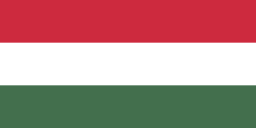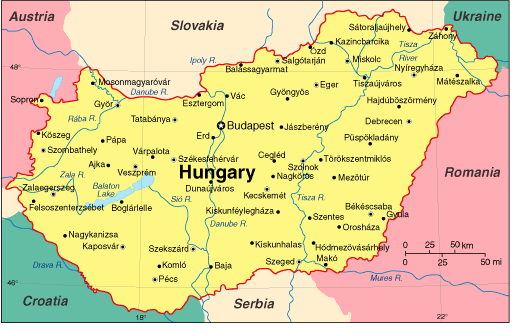
Hungary is a landlocked country whose borders have varied hugely over the centuries. The one constant is a population who speak a language unrelated to most other European tongues. In the 16th and 17th centuries much of the country came under Ottoman (Turkish) rule and the Muslim inhabitants were, naturally, circumcised. However, unlike some neighbouring countries, Muslim influence did not remain after the Turks were expelled. By the 18th century Hungary was Christian, but a mix of Catholic and Protestant Christianity, with sizable Eastern Orthodox communities among ethnic Romanians and Serbians. (Much of today's Romania was then part of Hungary.) From then until 1918, Hungary was part of the Hapsburg (Habsburg) monarchy and its successors, which favoured Catholicism.

Hungary was never entirely happy about being under the Hapsburg dominion and various revolts happened, the most successful being in 1848-49. The Jewish community strongly supported the Hungarian efforts to create a modern liberal country, "with liberty and justice for all". The end result (cutting a very long story short) was that Austria-Hungary became a joint monarchy, ruled by the Austrian Emperor who also bore the title King of Hungary, with each country having its own parliament. Austria-Hungary was one of the three major power-blocs in Europe. An excellent summary of Hungary's complicated history is by Brian Cartledge, former British ambassador in Budapest.
As in most continental European countries, in Hungary circumcision was traditionally performed only in the Jewish community or for medical reasons. In Austria-Hungary, Jews were given a formal legal status, an advanced idea at that time, and enjoyed full liberty and equality, and great prosperity. Most Jews in Hungary still belongs to the Neolog or reformed Judaism, which embraced Hungarian as liturgical language, gave up the traditional Ashkenazi attire and eased some of the Jewish dietary and other customs, though they retained the practice of circumcision.
European royalty largely adopted circumcision from the 18th century onwards but unlike in Britain this did not trickle down to the aristocracy.
After defeat in WW1 Austria-Hungary was dismembered and Hungary got its present borders. In WW2 it was part of the Axis powers and as such subject to German policies on Jewish extermination. About 440,000 Hungarian Jews were deported, and most were killed. However, once the fate of these deportees became known, the Hungarian government sought to protect Jews, and most of the Jews in the capital, Budapest, were saved.
Post-war, Hungary ended up in the Soviet bloc, under a puppet Communist regime. One attempt at an uprising (1956) was brutally crushed, and the country remained communist until the collapse of the Soviet hegemony in 1989. Under communism religious practices were frowned upon, but repression was not as severe as in Russia. Nevertheless, much of the remaining Jewish population, partly as a reaction against the horrors of the Nazi regime, became non-observant and gave up circumcision even though it was not banned. Medical circumcision was freely available, as in all Eastern Bloc countries at that time.
Post-1989, Hungary has witnessed a revival of Jewish culture and Jewish identity. Many Jews became observant again, and had themselves and their children circumcised. A major engine of Jewish revival is the Unified Jewish Community of Hungary, which is a traditionalist community with strong ties to the Chabad-Lubavitch movement. (Its website has extensive sections urging Jews to get circumcised. You can view a translation here. The chief rabbi of the community is also a certified mohel, while Neolog (reform) Jews usually use the services of Jewish doctors to get their boys circumcised. Teenagers and adults who return to Judaism are usually circumcised in the Jewish hospital, sometimes in the presence of a rabbi.
 Until very recently, there was no mass immigration to Hungary from the Muslim world, thus Hungary has a very small Muslim community, which is legally recognised by the Hungarian state. It is composed of immigrants (mostly former university students married to Hungarian women) and converts. Nevertheless, immigration may increase substantially in the next few years, and according to sources from the local Muslim community, conversion is on the rise. The community's website has an extensive section on circumcision, which confirms that circumcision is a must for Muslim men, but condemns female circumcision. Hungarian men who convert to Islam usually get circumcised shortly after conversion.
Until very recently, there was no mass immigration to Hungary from the Muslim world, thus Hungary has a very small Muslim community, which is legally recognised by the Hungarian state. It is composed of immigrants (mostly former university students married to Hungarian women) and converts. Nevertheless, immigration may increase substantially in the next few years, and according to sources from the local Muslim community, conversion is on the rise. The community's website has an extensive section on circumcision, which confirms that circumcision is a must for Muslim men, but condemns female circumcision. Hungarian men who convert to Islam usually get circumcised shortly after conversion.
While the uncircumcised man is still the norm in Hungary, non-medical and non-religious circumcision is becoming more and more popular, and men get circumcised more often for minor medical inconveniences (such as short frenum or the likes) than 25-30 years ago. Teenagers and young adults who get circumcised often refer to the influence of American porn movies, where almost all male actors are circumcised, or to the suggestion of girlfriends, who already had experience with circumcised men. Most circumcised Hungarian young men say that if and when they have sons born, they will go for infant or childhood circumcision.
The most popular Hungarian pro-circumcision website is www.korulmeteles.hu. 25-year-old Adam has agreed to be the public face of Hungarian circumcision,and he certainly is circumcised, as you can see below. There are more photographs of him here - some will ask if your are over 18, and be warned that these ones show erections.

András Jóvágásúfiú & JB
Copyright © 1992 - 2015, All Rights Reserved CIRCLIST.